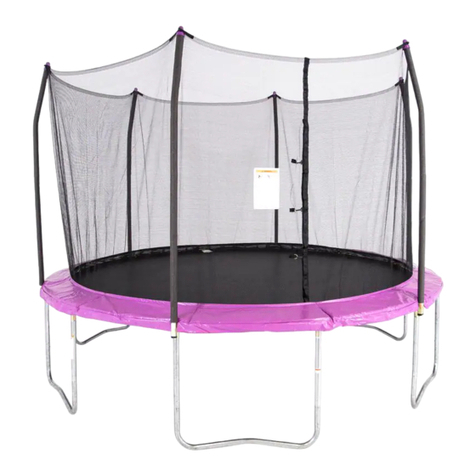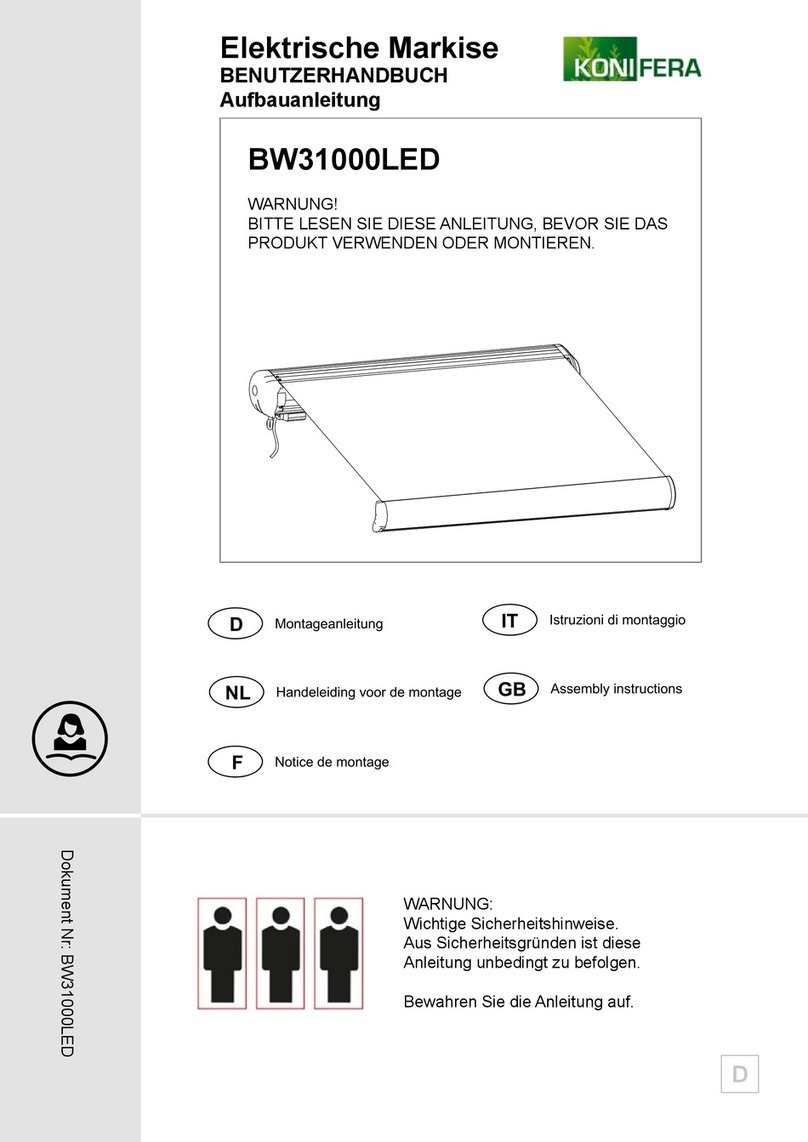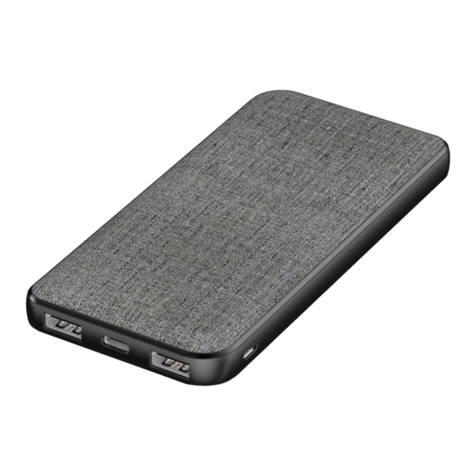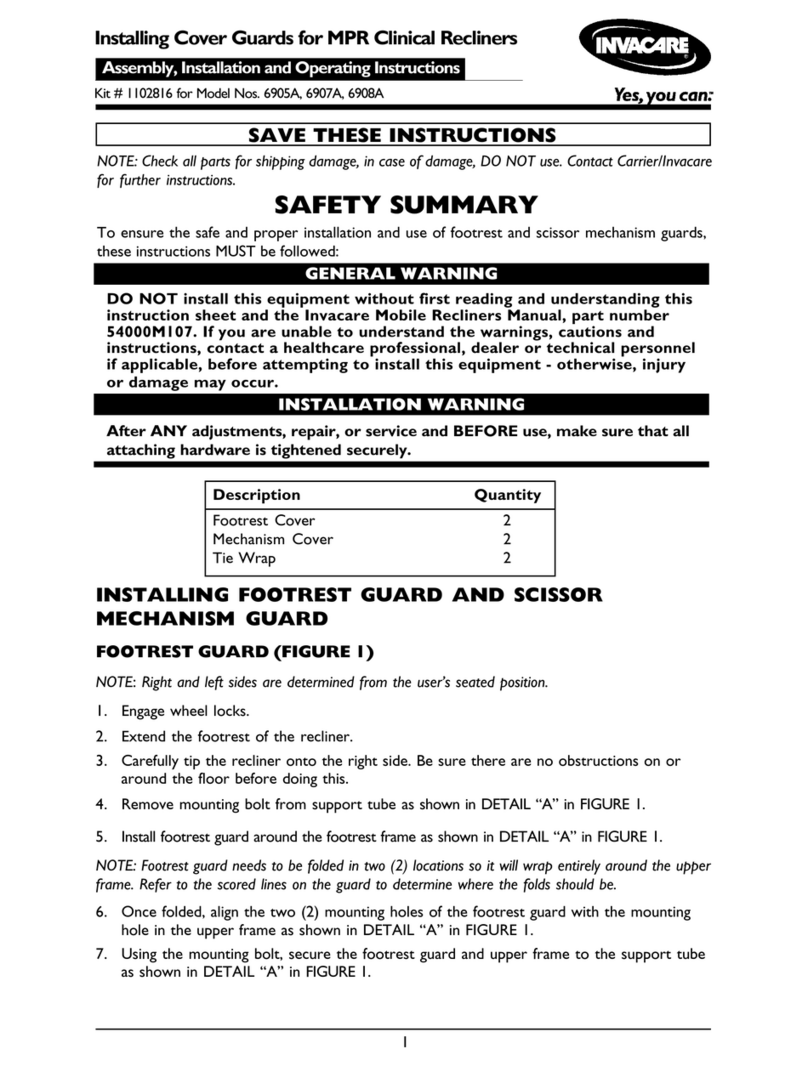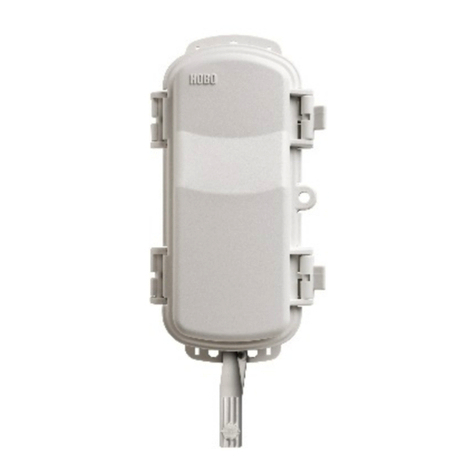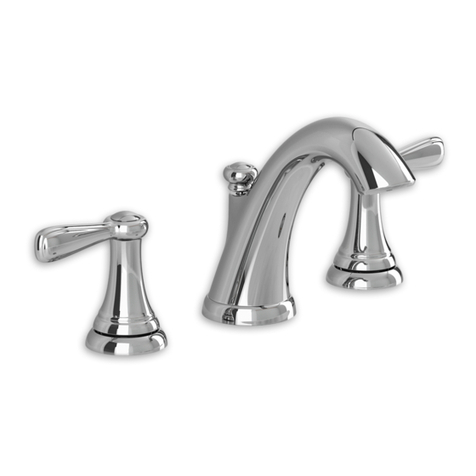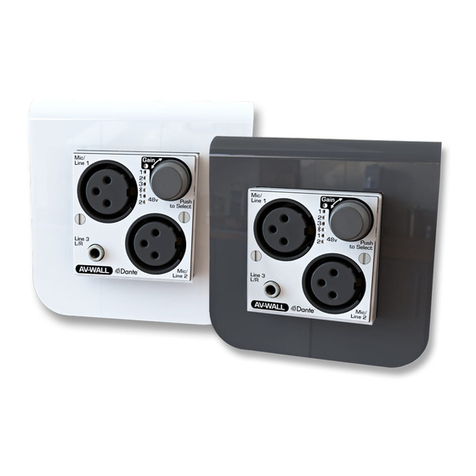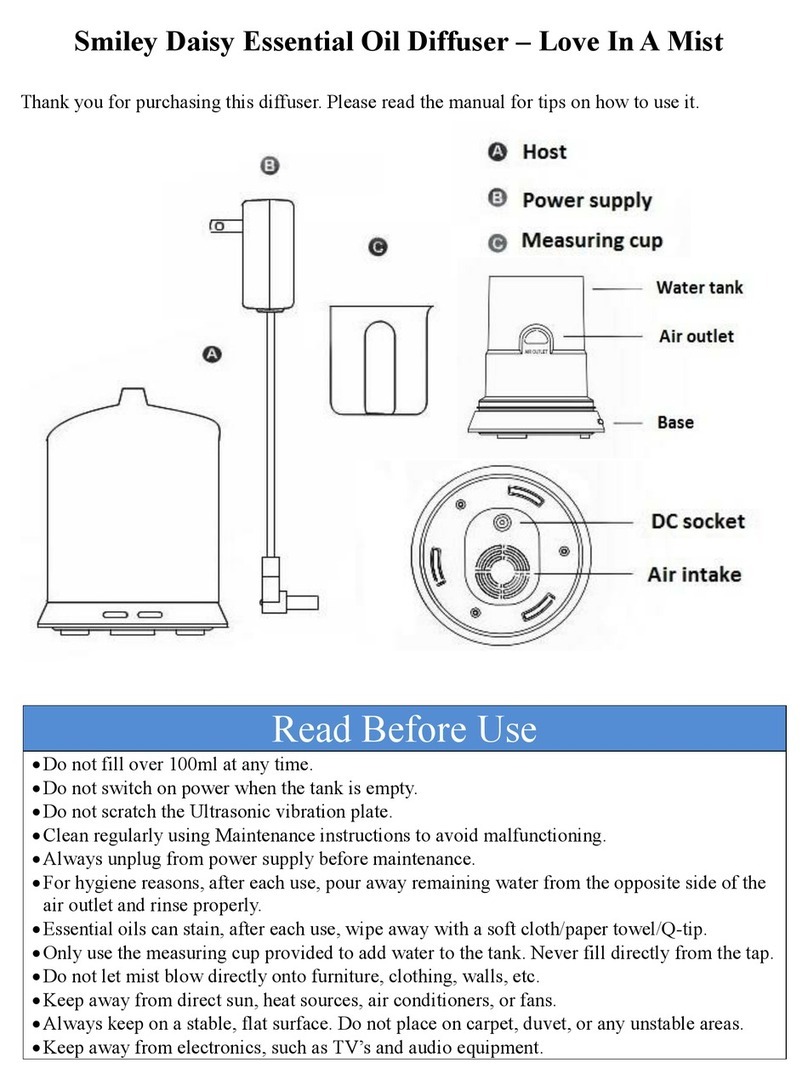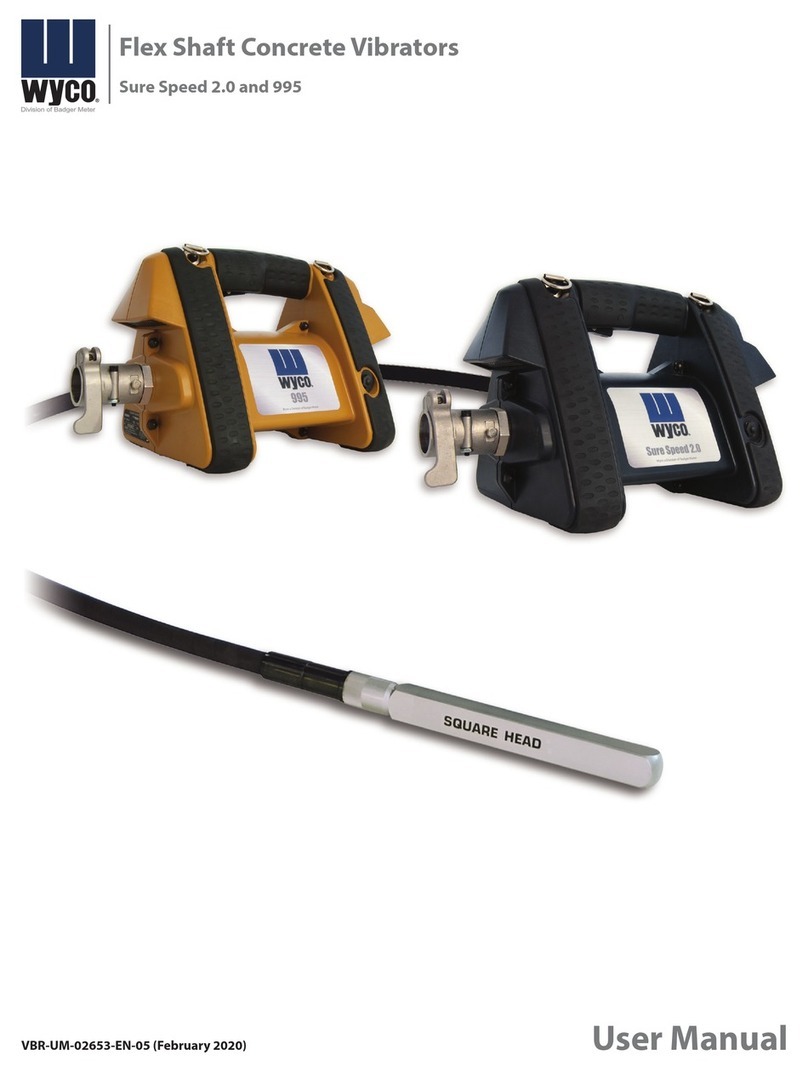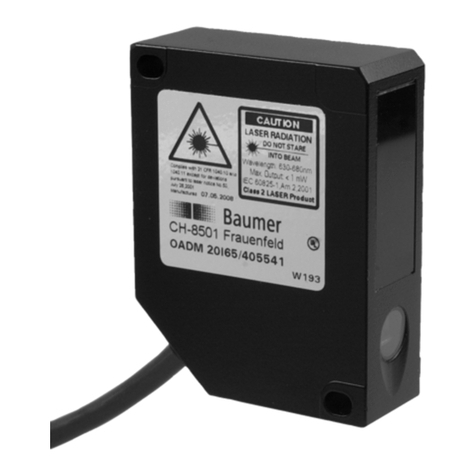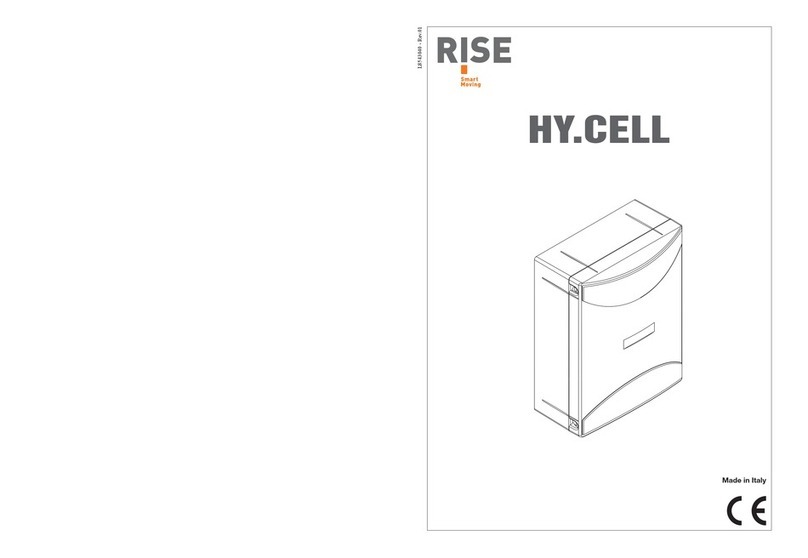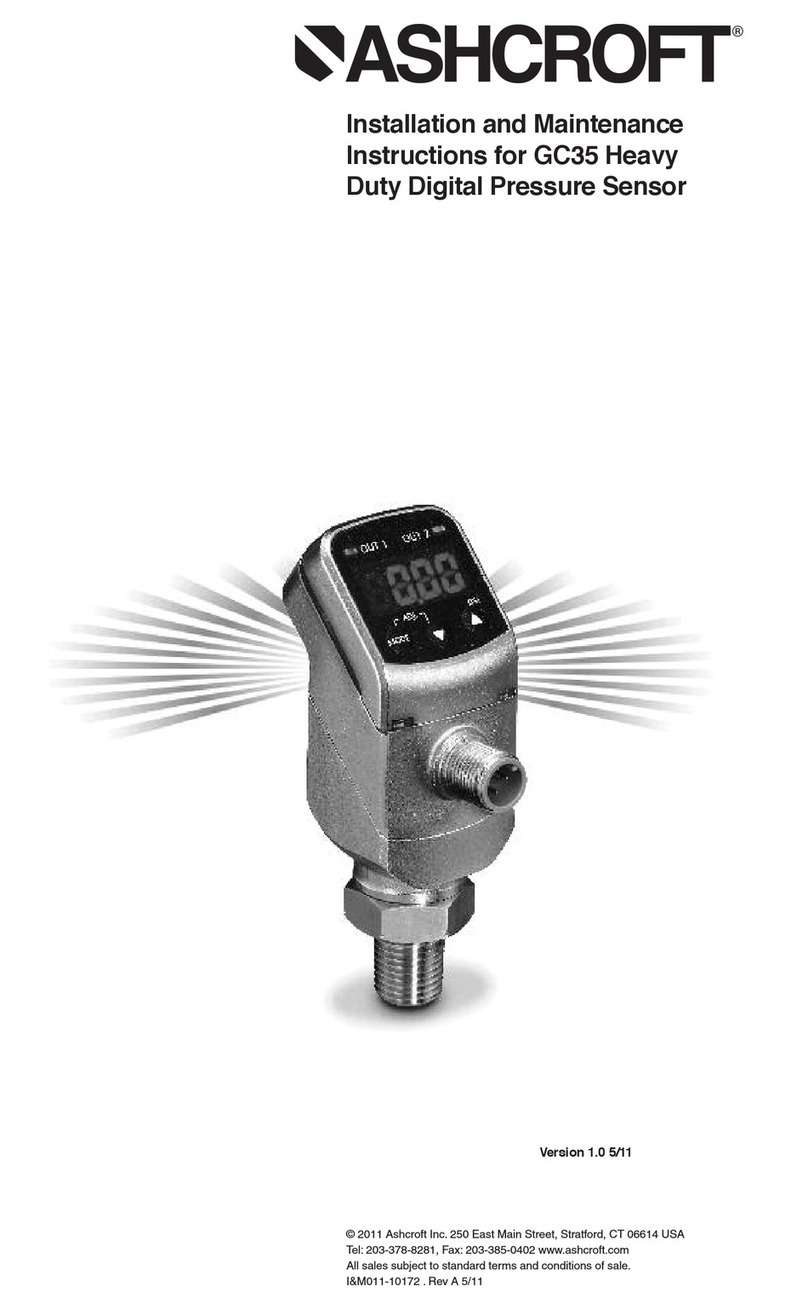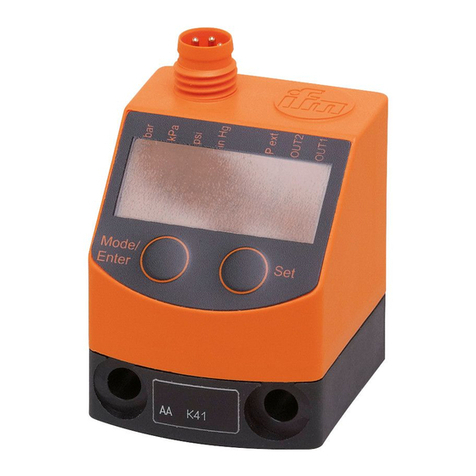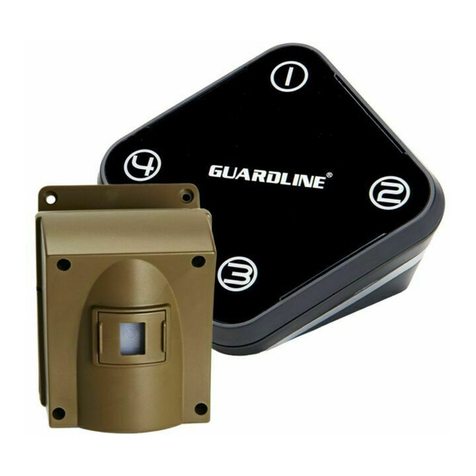Skywalker SBT60 Manual

Skywalker Holdings LLC
P.O. Box 574, Brigham City, UT 84302
MODEL #SBT60
WARNING
Read all precautions and instructions in
this manual before using this equipment.
Save this manual for future reference.
Maximum user weight 100 lbs.
USER MANUAL
ASSEMBLY, MAINTENANCE, &

2
Part List...........................................................................................................................................................................3
Part Identification...............................................................................................................................................4-5
Exploded Drawing....................................................................................................................................................6
Assembly.................................................................................................................................................................7-14
Maintenance and Care Information...........................................................................................................15
Warning Label Placement.................................................................................................................................15
Instructions for Use..............................................................................................................................................16
Methods of Accident Prevention.................................................................................................................17
Instructions and Model Lessons..........................................................................................................18-19
Trampoline Safety Information....................................................................................................................20
Enclosure Safety Information........................................................................................................................21
Learning Games and Activities...................................................................................................................22
Limited Warranty....................................................................................................................................................23
TABLE OF CONTENTS
IMPORTANT
Trampolines and enclosures are susceptible
to winds. Be sure to secure your trampoline
and enclosure. Wind damage is not covered
in the warranty of your trampoline.
WARNING
CHOKING HAZARD- Small
parts not for children
under 3 years.
WARNING
Adult assembly required.
STOP EVERYTHING YOU'RE DOING AND REGISTER YOUR TRAMPOLINE
Find our warranty registration online by typing in: www.skywalkertrampolines.com/registration/
You'll need to have the following information handy:
• Name • Email address
• Address • Trampoline model number
• Phone number • Trampoline serial number
• Date of purchase • Retailer the trampoline was purchased from
HEY WE'VE GOT SOMETHING REALLY IMPORTANT TO SAY
And that is... check us out online! We've got assembly videos (for those of you who prefer movies over books), FAQs
(so you know you're not the only one who messed up), fascinating blog posts (did you know jumping burns more
calories than running?), and most importantly... find us on social media! Because we want to be your friend. We'd love
to hear from you, friend.
Website: skywalkertrampolines.com
Facebook: facebook.com/skywalkertrampolines
YouTube: youtube.com/c/SkywalkerTrampolines
Pinterest: pinterest.com/swtrampolines
Twitter: twitter.com/swtrampolines
Instagram: instagram.com/skywalker_trampolines

Key No. Qty. Description
1 6 Frame Tube
2 6 Rail
3 6 Leg
4 1 Mat with Net
5 1 Pad with Net
6 36 Elastic with Ball
7 6 Curved Tube
8 6 Long Foam (Pre-installed)
9 6 Cap (Pre-installed)
10 1 8 Self-tapping Screw
11 6 Foam for Rail
12 6 Pole Cap
13 6 Short Foam (Pre-installed)
14 1 Screw Driver
# 1 User Manual
# 1 Warning Label
PART LIST
ORDERING REPLACEMENT PARTS
We get it... sometimes things happen. But the fun shouldn’t stop just because you need a new bolt or screw! To order
replacement parts, check out our website at: www.skywalkertrampolines.com or call our toll-free Customer Care
Hot-line at 1-866-603-Jump (5867), Monday - Friday, 8 a.m. until 5 p.m. Mountain Time (excluding holidays).
Our customer service team will ask you a few questions in order to get the replacement part sent out as soon as
possible. We’re not trying to complicate your life, we promise.
When calling, make sure to have the following information ready:
• The model # of the product (see the front cover of this manual)
• The key # and description of the part (see the part list above)
• The quantity needed (only you know the answer to that one!)
BEFORE YOU BEGIN
Thanks for choosing Skywalker Trampolines! We’re just as excited as you are to help your family live an active (but
most importantly FUN) lifestyle. This model is one of our favorites, and we’re confident you’ll love it too. To make
things easier for you, we’ve listed important information that you (and your little outdoor adventurers) need to know.
Make sure you brush up on the warnings, instructions, assembly, maintenance, and use of your new product...
because there will be a pop quiz at the end! (Okay, not REALLY, but if you’re still reading this, props to you! You’re
awesome). 3

4
Before you begin, take a look at the drawings below to make sure you have all the parts! The numbers in the squares
to the left (key numbers) will help you identify the parts during assembly.
PART IDENTIFICATION
1 2 3
456
78
Frame Tube (x6) Leg (x6)
Rail (x6)
Mat with Net (x1) Pad with Net (x1) Elastic with Ball (x36)
Curved Tube (x6) Long Foam (x6)
(Pre-installed) 9
10 11 Foam for Rail (x6) Pole Cap (x6)
12
Cap (x6)
(Pre-installed)
Self-tapping
Screw (x18)

5
13 Short Foam (x6)
(Pre-installed) 14 Screw Driver (x1)

EXPLODED DRAWING
6
(3)
(3)
(3)
(3)
(1)
(1)
(1)
(1)
(1)
(1)
(3)
(10)
(9)
(9)
(9)
(9)
(9)
(9)
(10) (10)
(10)
(12)
(12)
(12)
(12)
(12)
(10)
(6)
(5)
(7)
(2)
(2)
(2)
(2)
(2)
(2)
(7)
(7)
(7)
(7) (7)
(4)
(10)
(10)

READ THIS BEFORE YOU BEGIN
• You’ll probably need at least 2 adults and 2 hours to assemble your trampoline (of course, that depends on what
model you have, and whether or not you’re secretly a superhero).
• We’ve provided a Phillip’s screw driver to help with assembly, but you’re more than welcome to use your own
tools. Many find that using a power drill makes things easier.
• Use gloves to protect your hands from pinch points during assembly. Plus, it’s an up-and-coming fashion trend.
• The assembly steps refer to parts by their descriptions and key numbers (see the part list on page 3).
• The assembly steps are written in a specific order, and if you don’t follow them exactly... you may end up having to
start all over again. We promise we won’t say, “I told you so” but really... we told you so.
• Most importantly... YOU’VE GOT THIS. YOU’RE THE BEST TRAMPOLINE ASSEMBLER AROUND. This may not be the
easiest thing you’ve ever done... but it will be worth it. Trust us.
And if you’re a visual learner, check out our assembly videos!
ASSEMBLY
STEP 2
Insert the smaller end of one frame tube (1) into the larger end of another
frame tube (1). Make sure the larger diameter ends face the ground!
Now that you’re a pro, repeat this step with the four remaining frame tubes.
Frame Tube (x6)
1
7
STEP 1
Register your trampoline! For info on warranty registration, see page 2.
Visit:youtube.com/c/SkywalkerTrampolines
Big diameter end
Big diameter end
Small diameter end
Small diameter end (1) (1)

8
STEP 3
Now all you need to do is connect the frame pieces together! (See, this isn’t too bad... is it?)
Remember, the ends with the larger diameter should face the ground!
STEP 4
Insert one leg (3) into the larger diameter end of the frame tube (1), and
tighten using one self-tapping screw (10).
Repeat this step until you have all 6 legs assembled!
Leg (x6)
3Self-tapping
Screw (x6)
10
ASSEMBLY
Big diameter end
(10) (10)
(10)
(10)
(3)
Big diameter
(1)

9
Place the mat with net (4) on the ground inside the frame. Make sure
the door is centered between the two legs!Then, using one elastic
with ball (6) attach the mat to the frame in location A. Repeat this
step to attach five remaining elastic bands in locations B-C-D-E-F as
shown. One elastic band should be centered in between each leg.
STEP 5
Mat with Net (x1) Elastic with
Ball (x6)
46
Following the pattern below and beginning with the 7th band, continue to
place the elastic bands around the frame in a clockwise direction until all 30
bands are used. Make sure the balls on the elastic bands are located on the
underside of the trampoline! After all the elastics have been placed, if the
mat is not in the middle of the frame, spend some time adjusting it by pulling
on the elastics with balls.
STEP 6
Elastic with Ball (x30)
6
7th
8th
9th
10th
11th
12th
13th
14th
15th
16th 17th
18th
19th
A
B
C
D
E
F

10
STEP 7
Pad with Net (x1)
5
ASSEMBLY
Fasten the net to the bottom of each leg using the self-tapping screws (10).
STEP 8
Self-tapping Screw (x6)
10
At this point the frame may not lay flat on the ground... but don’t freak out!
The frame will straighten out with further assembly. Lay the pad with net
(5) on the frame. Adjust the position of the pad so that the slits are directly
above the legs. Insert the top of the legs into the slits in the pad. Note: It
might be a good idea to place the seam of the net opposite of the enclosure
door.
(10)
(10) (10)
(10)

11
STEP 9
Pole Cap (x6)
12
Curved Tube (x6)
7
Insert the bottom (the curved section) of one curved tube (7) into a leg
piece as shown. The tube should be curving in towards the mat, and the
short horizontal piece on the middle of the tube should be facing inwards as
well.
Repeat this step to insert 5 more curved tubes.
STEP 10
Now place one pole cap (12) on top of each curved tube.
Make sure the pole caps are pushed all the way down!
Curves in towards mat
(7)
(12)

12
STEP 11
Foam for Rail [X6)
11
Unfold the enclosure net attached to the mat, and locate the sleeves sewn
on the inside of the net. Slide a piece of foam (11) into one of the sleeves
inside the net (4).
Repeat this step until all foam pieces have been places inside the sleeves.
ASSEMBLY
STEP 12
Rail (x6)
2
Insert a rail (2) into the foam (11) inside the sleeve. Make sure the rail is
curved inwards. Repeat this step until all of the rail sections have been
inserted into the foam and sleeves.
Make sure the ends are alternating, so one end of the rail will fit inside the
other.
Sleeve
Sleeve
(11) (11)
Small end
Big end (2)
Big end

13
STEP 13
Next, push the end of one rail out of the net hole, to the outside of the net. Then, insert the rail end into the short
horizontal tube located on the curved tube (7). Repeat this step with an adjacent rail. The smaller end of one rail
should fit inside the larger end of the other rail with both ends inside of the short horizontal tube. Repeat this
process to assemble all rails together. This step may be a little tricky... so grab a friend to help! When you reach
the last curved tube that has not yet been placed, insert it into the leg piece and connect the last rail tubes to
complete the circle.
(7) (7)
Small end
Big end
Big end Big end
Short horizontal tube
STEP 14
Place the straps that are at the top of the enclosure net over the pole caps (12).
(12)
(4)
Strap

LAST STEP YOU’RE IN THE FINAL HOME STRETCH.
Insert self-tapping screws (10) into the holes at the bottom of the enclosure
poles. Tighten to secure in place.
STEP 15
Self-tapping Screw (x6)
10
STEP 16
Congratulations on completing your new trampoline! (See... we knew you could do it!) So here comes the
real question... are you satisfied with this completed product? If you are, go ahead and write a review on the
retailer’s site you bought it from. We’d really appreciate it... and if we could, we’d give you a gold star. Are you
completely frustrated and have some choice words for us? Contact us directly! We’re not trying to ruin your life,
we promise. And we’ll do everything we can to make it right again. See contact info on page 2-3.
ASSEMBLY
14
(10)

MAINTENANCE & CARE INFORMATION
Congratulations and high five on successfully assembling your new Skywalker Trampolines Mini Bouncer! Now, the
best way to keep your new trampoline in tip top shape, is to periodically check for:
• Missing, improperly positioned, or insecurely attached frame padding, netting, enclosure tubes, or foam sleeves
• Punctures, frays, tears, or holes worn in the mat, frame padding, netting or foam sleeves
• Deterioration in the stitching or fabric of the mat, frame padding or netting
• Ruptured or missing springs
• Bent or broken frame, leg or enclosure tubes
• Sagging bed or netting
• Sharp protrusions on the frame, suspension system or enclosure tubes
If you notice any of the above conditions, please disassemble the trampoline and/or the enclosure net until new
parts are ordered!
Moving the Trampoline and Enclosure
If the trampoline and enclosure needs to be moved, it should be moved by two persons, kept horizontal, and lifted
slightly. If necessary, the trampoline and enclosure can be taken apart for moving. To take the trampoline apart,
follow the assembly steps in reverse order. Do not attempt to take the frame sections, legs, or bases apart before the
mat and springs have been removed.
Don't forget to check us out online! We'd love to hear from you.
Website: skywalkertrampolines.com
Facebook: facebook.com/skywalkertrampolines
YouTube: youtube.com/channel/UCUty7EqwIGouK5ovzGpHGrw/feed
Pinterest: pinterest.com/swtrampolines
Twitter: twitter.com/swtrampolines?lang=en
Instagram: instagram.com/skywalker_trampolines/?hl=en
15
The labels shown on this page have
been attached to the trampoline in
the indicated locations. The safety
instructions placard will need to be
attached by the owner. If one of the
labels or the placard is missing or
illegible, call our Customer Care Hot
Line toll-free at 1-866-603-JUMP
(5867), Monday through Friday, 8 a.m.
until 5 p.m. Mountain Time, to order a
free replacement label or placard.
The placard shown above was sewn
to the trampoline enclosure netting.
Note: The labels and placard shown
are not actual size.
WARNING LABEL PLACEMENT
• Do not use without frame pads.
• Do not attempt or allow somersaults.
Landing on the head or neck can
cause serious injury, paralysis, or
death, even when landing in the middle
of the bed.
• Inspect the trampoline and parts
before use. Replace any worn or
damaged parts.
• One person on the trampoline at a time.
Use by more than one person at the
same time increases the chances of
injury.
• Use trampoline only with mature,
knowledgeable supervision.
WARNING

16
To reduce the risk of serious injury, read and follow all of the warnings, precautions, and instructions in this manual before you use the
trampoline enclosure. Warnings and instructions for care, maintenance, and use of this trampoline and enclosure are included to promote safe
enjoyable use of this equipment.
1. It is the responsibility of the owner and supervisors of the
trampoline and enclosure to make sure all users obey the
safety instructions given in this manual. The trampoline should
only be used with mature, knowledgeable supervision.
2. Secure the trampoline and trampoline enclosure against
unauthorized and unsupervised use. If you use a ladder to
get on and off the trampoline, be sure to remove it when the
trampoline and enclosure are not being used.
3. Be sure there is enough clear space above the trampoline and
enclosure before use. It is best to have at least 24 feet (7.3
meters) of clear space above the ground. This space must be
clear of wires, tree limbs, and any other possible hazards.
4. Lateral (sideways) clearance is very important. Do not place
the trampoline and enclosure near walls, buildings, fences,
sidewalks, and other play areas. Always keep a clear space on
all sides of the trampoline and enclosure.
5. Remove any objects that could interfere with the performer.
Maintain a clear area around and under the trampoline.
6. Be sure the trampoline and enclosure are on a level surface
before use.
7. Always inspect the trampoline and enclosure before each
use. Make sure that the frame, padding, netting, enclosure
tubes, and foam sleeves are correctly and securely positioned.
Replace any worn, defective, or missing parts. (Jumpers may
be hurt if the trampoline and enclosure are used when they are
in poor condition.)
8. Bounce only when the surface of the mat (bed) is dry. There
should be very little or no wind or air movement. The trampoline
and enclosure must not be used in gusty or severe winds.
9. The trampoline and enclosure frames are made of metal. They
are not grounded and will conduct electricity. For this reason,
an electrocution hazard exists. No lights, electric heaters,
extension cords, or household electrical appliances are to be
permitted on the trampoline or in enclosure at any time.
10. Use the trampoline and enclosure in an area with lots of light.
If the trampoline and enclosure are indoors or in shady areas,
you may need to us artificial (electrical) lighting in the area.
11. During the winter months, the trampoline soft materials will
need to be removed and stored in a dry place. If left up in the
winter months, it may cause damage to the springs, jump mat,
spring pad, and enclosure. The warranty will be void.
12. This trampoline and enclosure is made for users who weigh
less than 100 lbs.
13. This Trampoline is designed for 3-7 years of age.
14. The trampoline enclosure is to be used only with the size of
trampoline for which the enclosure is designed.
15. Misuse and abuse of the trampoline enclosure is dangerous
and can cause serious injury.
16. Do not attach anything to the enclosure barrier that is not a
manufacturer-approved accessory or part of the enclosure
system.
17. Please remove any jewelry before jumping begins. Jewelry may
get caught in the enclosure netting.
18. Wear clothing free of drawstrings, hooks, loops, or anything
that could be caught while using the trampoline/enclosure and
result in entanglement, strangulation, or both.
19. DO NOT let more than one person inside the trampoline
enclosure at the same time. Two or more people jumping at the
same time can cause serious injury.
20. DO NOT jump on the trampoline while you have or are holding
any objects, especially something sharp or breakable.
21. DO NOT use the trampoline and enclosure if you have been
using alcohol or drugs.
22. DO NOT attempt or allow somersaults (flips) on the trampoline.
Landing on the head or neck can cause serious injury,
paralysis, or death, even when landing in the middle of the
jumping mat.
23. Always climb on to and off of the trampoline. It is a dangerous
practice to jump from the trampoline to the floor or ground
when dismounting, or to jump onto the trampoline when
mounting.
24. DO NOT use the trampoline as a springboard to other objects.
Enter and exit the enclosure only at the enclosure door or
barrier made for that purpose.
25. DO NOT attempt to crawl under, jump over, intentionally bounce
off of, hang from, climb on, kick, or cut the barrier netting.
26. While keeping head erect, focus eyes on the trampoline toward
the perimeter. This will help control bounce.
27. Stop bouncing by flexing knees as feet come in contact with
the trampoline bed. Learn this skill before attempting others.
28. Avoid bouncing too high. Stay low until bounce control and
repeated landings in the center of the trampoline can be
accomplished. Control is more important than height.
29. Avoid bouncing when tired. Keep turns short.
30. Learn fundamental bounces and body positions thoroughly
before trying more advanced skills. A variety of trampoline
activities can be carried out performing the basic
fundamentals in various series and combinations, performing
one fundamental after another, with feet bounces between
them.
31. For additional information concerning the trampoline equipment
contact the manufacturer. For information concerning skill
training, contact a certified trampoline instructor.
32. Do not use or stand near the trampoline in windy or gusty
conditions. A trampoline can become airborne when exposed
to sustained wind or gusting wind conditions. This can result in
serious injury, paralysis, or death, as well as property damage.
To reduce these risks, disassemble the trampoline and
enclosure and store them until weather conditions improve.
Anchoring a trampoline frame may prevent the trampoline from
moving as a result of the wind, but even anchored trampolines
can become airborne or damaged. Consult a qualified
contractor to determine what type of anchor works best in
your location.
INSTRUCTIONS FOR USE

THE SUPERVISOR’S ROLE IN PREVENTING ACCIDENTS
It is the responsibility of the supervisors of trampoline users to provide knowledgeable and mature supervision. They
need to know and enforce all of the rules and warnings printed in this manual to minimize the likelihood of accidents
and injuries. They also need to inform users of these rules. During periods of time when supervision is unavailable
or inadequate, this may require that the trampoline is taken down, placed in a secure area, or otherwise secured
against unauthorized use. Another option that may be considered is covering the trampoline with a heavy tarp
that can be secured with locks and chains. It is the responsibility of the supervisor to make sure that the placard
with trampoline safety instructions is kept posted on the trampoline and that jumpers are informed about these
instructions.
THE JUMPER’S ROLE IN PREVENTING ACCIDENTS
Education on the part of the user is a must for safety. Users must first learn a low, controlled bounce and then learn
the basic landing positions and combinations before proceeding to intermediate skills. Jumpers must understand
why they have to master “control” before they can start thinking about other moves. Understanding the proper
progression of skills in jumping on a trampoline must be the first lesson. Review this manual to learn about the basic
techniques for using the trampoline. Follow the rules on the placard with trampoline safety instructions (see step []
in assembly instructions). For further information or additional instructional materials, contact a certified trampoline
instructor.
TRAMPOLINE SAFETY INSTRUCTIONS
For the Supervisor
Read the instructions before using the trampoline. Enforce all of the safety rules. Become familiar with the
information in this manual so you can help new users learn basic jumps and all users follow trampoline safety. All
trampoline users must have mature, knowledgeable supervision, regardless of their skill or age. This trampoline is
not recommended for use by children under 6 years of age. Inspect the trampoline before using it. Do not use the
trampoline without the frame pad securely in place to cover the frame. Do not use the trampoline in wet or windy
conditions. A worn or damaged mat, spring, or frame piece should be replaced immediately.
Jumping
Learn fundamental jumps and body positions thoroughly before trying more advanced skills. Know your own limits
in performing each of the trampoline jumps. Study this manual to learn how to do basic jumps. Stop your bounce
by flexing your knees as your feet come in contact with the trampoline mat. Learn this skill before attempting any
others.
HAZARDS ASSOCIATED WITH HIGH WINDS
A trampoline with an enclosure can be moved or blown over by high winds. Anyone in its path, or inside of the
enclosure, may be injured if this happens. If you expect high winds, take down the enclosure netting and stake the
trampoline frame to the ground, or move the trampoline and enclosure to a sheltered location. The only sure method
to protect your trampoline and the surrounding environment during high winds is to completely disassemble the unit
and store indoors. Damage due to wind or weather is not warranted.
METHODS OF ACCIDENT PREVENTION
17

Lesson 1: Fundamental Bounce
1. Start from a standing position with your head erect
and your eyes on the frame pad.
2. Swing your arms forward and up in a circular motion.
3. Bring your feet together and point your toes
downward while in the air.
4. Keep your feet about 15 inches apart when landing on
the mat.
INSTRUCTIONS & MODEL LESSONS
The following lessons are examples of an instructional program. They should follow a complete discussion and
demonstration of body mechanics between the supervision and the student(s).
1. Mounting and dismounting: Demonstration and practice of proper techniques.
2. Fundamental bounce: Demonstration and practice.
3. Breaking: Demonstration and practice. Breaking on command.
4. Hand and knee drop: Demonstration and practice, stressing four-point landing and alignment.
Lesson 2: Knee Drop
1. Start bouncing from a standing position, keeping your
eyes on the frame pad.
2. Land on your knees, keeping your back straight and
your body erect.
3. Come back up to an erect position.
Lesson 3: Hand and Knee Drop
1. Start bouncing from a standing position, keeping your
eyes on the frame pad.
2. Land on the mat on your hands and knees.
3. Push with your hands and come back up to an erect
position.
Lesson 4: Back Drop
1. Start from a low bounce and land on your back.
3. Keep your chin forward on your chest as you land.
4. Kick forward and up with your legs to return to an
erect position.
18

Once each of lessons are learned, the student should now be encouraged to design and organize routines, with
emphasis on good form. The instructor may judge or grade students and arrange groupings for further instruction
accordingly.
To stimulate interest in competition, the game of “Trampoline Horse” can be introduced. Before the game begins,
students must count off. To start the game, student number 1 performs a stunt. Student number 2 then mounts the
trampoline, performs the same stunt and adds a second stunt. Student number 3 mounts and performs stunts 1 and
2 and adds a third stunt. Thus the series of stunts is continuously lengthened. The first person to miss a stunt in the
series assumes the letter “H” and starts a new series with a stunt. If a person misses again, he assumes the letter
“O.” When a person accumulates “H-O-R-S-E,” he or she is eliminated from the game. The last remaining contestant
is the winner. Lesson planning from this point on should be facilitated by contacting a certified trampoline instructor.
Lesson 5: Seat Drop
1. Land in a sitting position with your legs parallel to the
mat.
2. Place your hands on the mat beside your hips.
3. Push with your hands to return to an erect position.
Lesson 6: Front Drop
1. Start from a low bounce and land on the mat in a
prone position.
2. Keep your head up and your arms extended forward
on the mat.
3. Push with your arms to return to an erect position.
Lesson 7: Half Turntable
1. Start from the front drop position and push to the
left or right with your arms turning your body in the
opposite direction.
2. Turn your head and shoulders toward the direction
that your body is turning.
4. Keep your back parallel to the mat and your head up.
5. After completing a half turn, land in the front drop
position.
Lesson 8: Swivel Hips
1. Start with a seat drop.
3. Turn your head to the left or right and swing your
arms up in the same direction.
4. Turn your hips in the same direction as your head and
arms, completing a twist.
5. Land in the seat drop position.
4. Keep your back parallel to the mat and your head up.
5. After completing a half turn, land in the front drop
position.
19

In trampoline use, as in all active recreational sports, participants can be injured. However, there are steps that can
be taken to reduce risk of injury. In this section, primary accident patterns are identified and the responsibilities of
supervisors and jumpers in accident prevention are described.
ACCIDENT CLASSIFICATION
Somersaults (flips): Landing on your head or neck, even in the middle of the trampoline mat, increases the risk of
a broken back or neck, which can result in paralysis or death. Such events can occur when a jumper makes an
error trying to perform a forward or backward somersault (flip). Do not perform somersaults(flips) on this backyard
trampoline.
Multiple Jumpers: More than one jumper at a time on the trampoline increases the chance of a jumper becoming
injured by losing control of his or her jump. Jumpers may collide with one another, fall off of the trampoline, fall onto
or through the springs, or land incorrectly on the mat. The jumper weighing the least is the jumper most likely to be
injured.
Mounting and Dismounting (Getting on and off): The trampoline mat is several feet above ground level. Jumping from
the trampoline to the ground or any other surface may result in injury. Jumping onto the trampoline from a roof, deck,
or other objects also presents a risk of injury. Smaller children may need assistance getting onto or down from the
trampoline. Climb carefully onto and off of the trampoline. Do not step onto the springs or the fame pad. Do not grasp
the frame pad to pull yourself onto the trampoline.
Striking the Frame or the Springs: Injury may result from hitting the frame or falling through the springs while jumping
or getting onto or off of the trampoline. Stay in the center of the mat when jumping. Be sure to keep the frame pad in
place to cover the fame. The frame pad is not made or intended to support the weight of trampoline user. Do not step
or jump directly on the frame pad.
Loss of Control: Jumpers who lose control of their jumps may land on the mat incorrectly, land on the frame or
springs, or fall off of the trampoline. A controlled jump is one where the landing is in the same spot as the takeoff.
Before learning a more difficult stunt, you should be able to do one over an over with control. Attempting a stunt
beyond present skill levels increases the chance of loss of control. To regain control and stop your jump bend your
knees sharply when you land.
Alcohol or Drug Use: The chance of injury increases when a jumper has consumed alcohol or taken drugs. These
substances impair a person’s reaction time, judgment, and physical coordination.
Encountering Objects: Jumping on a trampoline while other people, pets, or objects are underneath it will increase
the chance of getting hurt. Jumping while holding or having an object on the trampoline, particularly one that is
sharp or breakable, will increase the chance of injury. Placing a trampoline too close to overhead electrical wires, tree
limbs, or other objects can increase the chance of injury.
Poor Maintenance of The Trampoline: Jumpers may be injured if a trampoline is in poor condition. A torn mat, bent
frame, broken spring, or missing frame pad, for example, should be replaced before anyone is allowed to jump.
Inspect the trampoline before each use.
Weather Conditions: A wet trampoline is too slippery for safe jumping. Gusty or high winds can cause jumpers to lose
control. To reduce the chance of injury, use the trampoline only when the weather is good.
Access: To prevent access to the trampoline by unsupervised smaller children, the optional access ladder should
always be taken away and stored in a safe place when the trampoline is not in use.
TRAMPOLINE SAFETY INFORMATION
20
Table of contents
Other Skywalker Accessories manuals
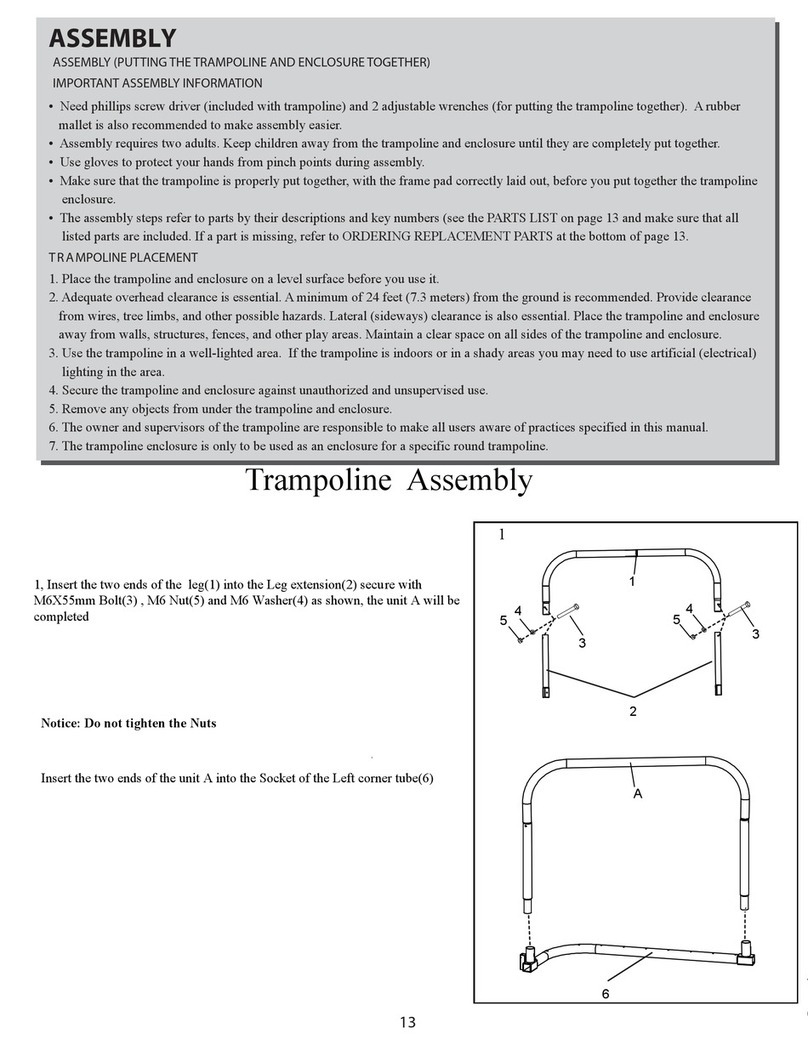
Skywalker
Skywalker STRC712G User manual

Skywalker
Skywalker SWBB1200 User manual
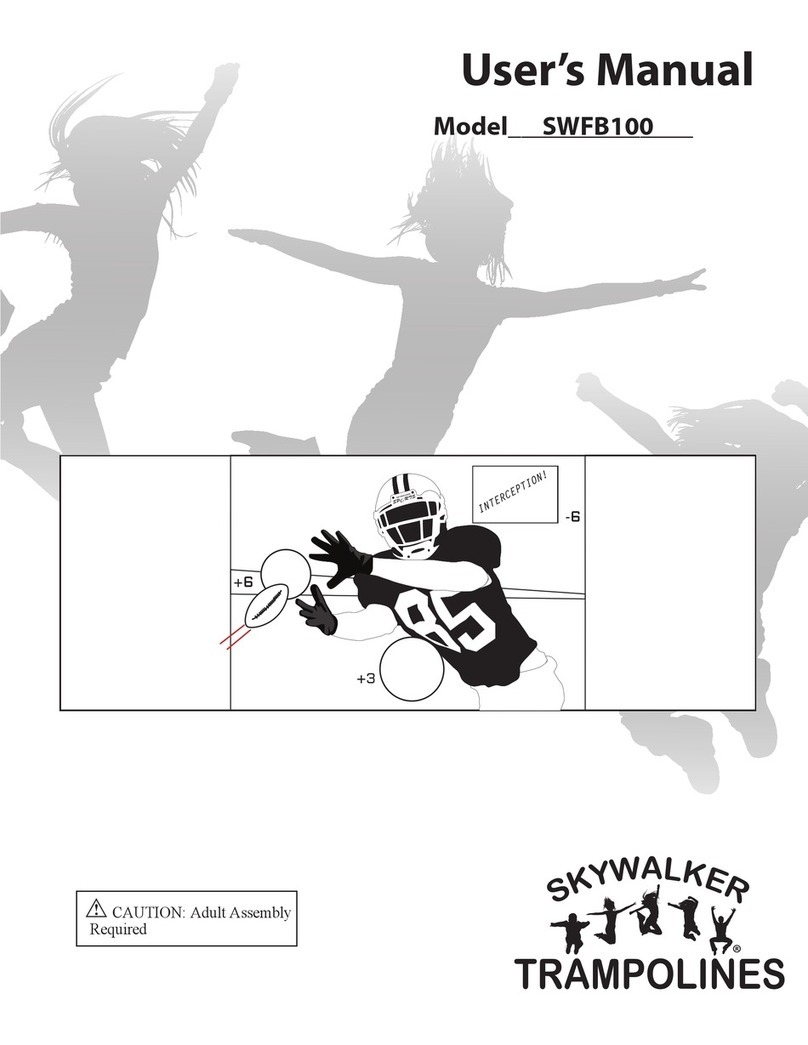
Skywalker
Skywalker SWFB100 User manual

Skywalker
Skywalker SAK140 User manual
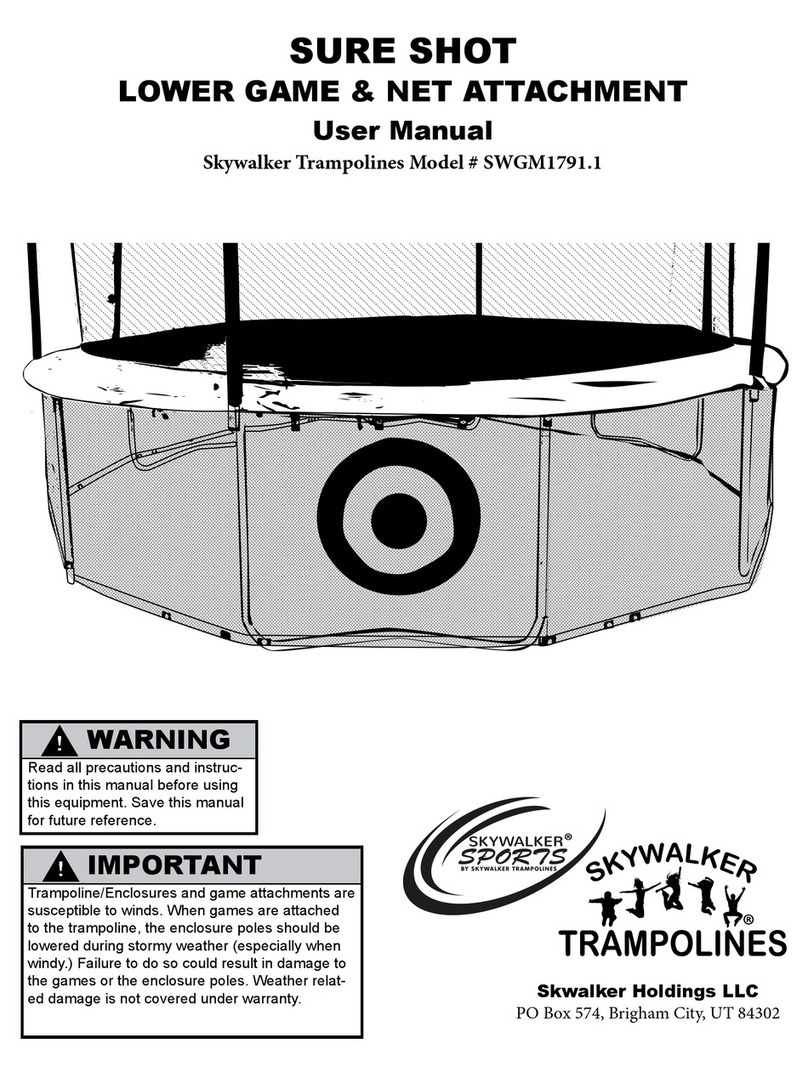
Skywalker
Skywalker SURE SHOT SWGM1791.1 User manual
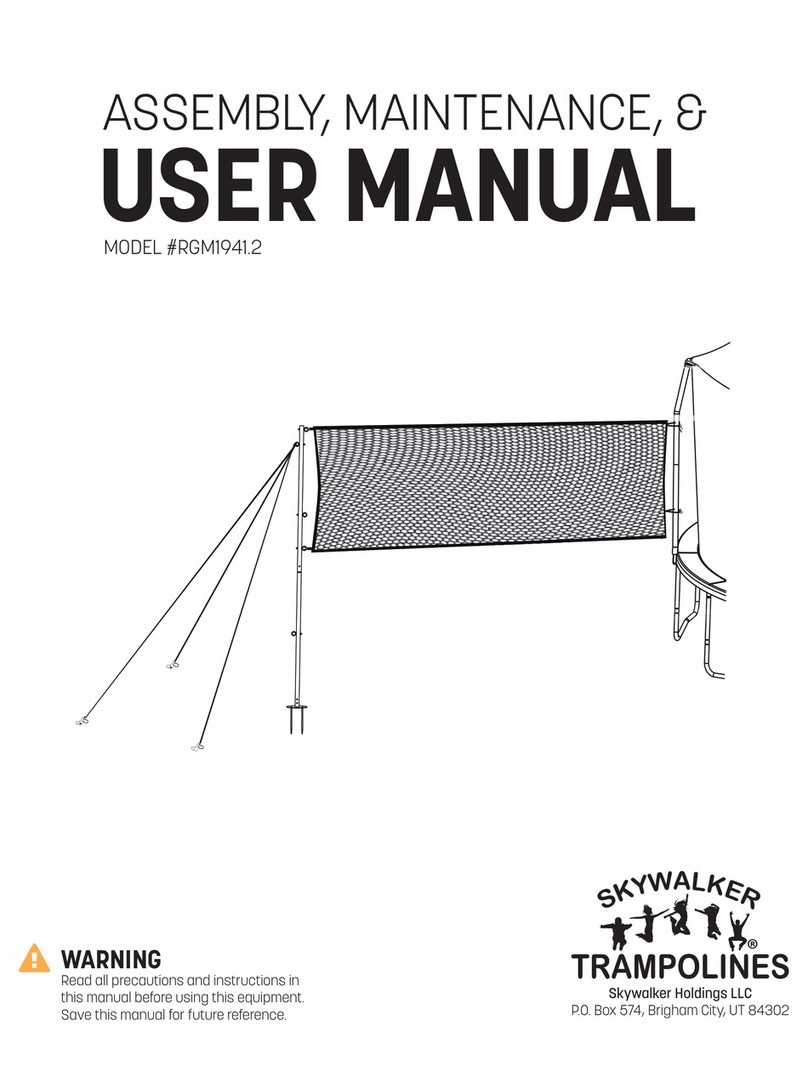
Skywalker
Skywalker RGM1941.2 User manual

Skywalker
Skywalker SWGM100 User manual
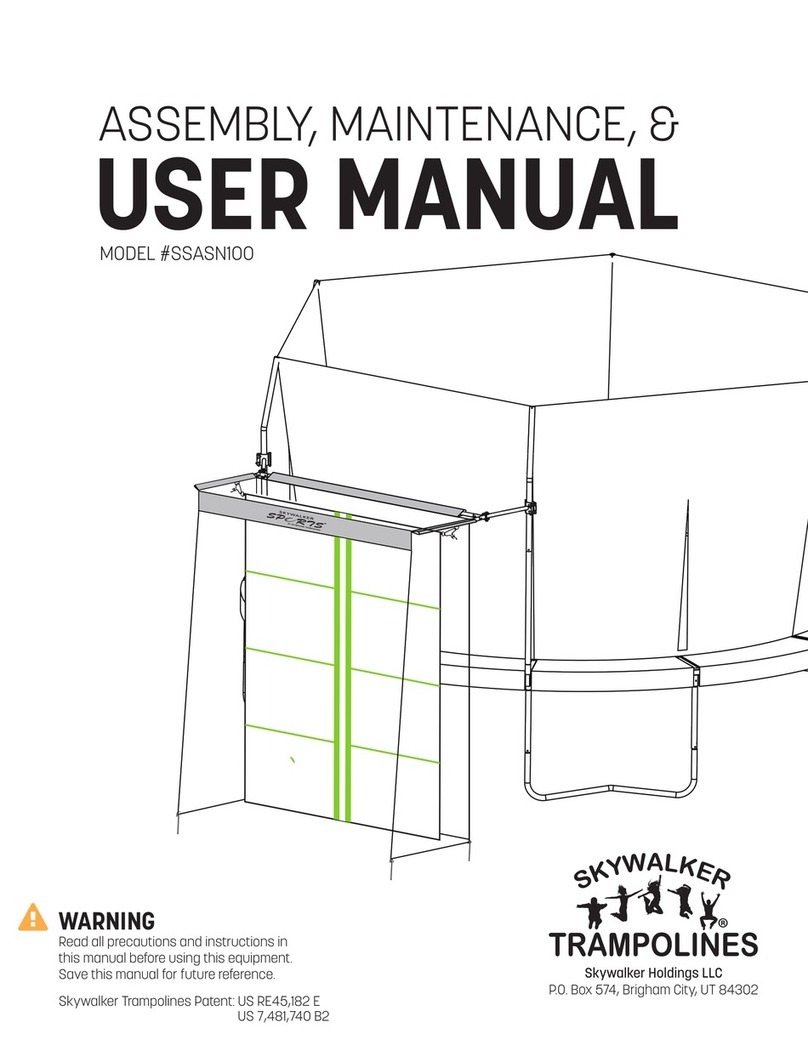
Skywalker
Skywalker SSASN100 Quick guide
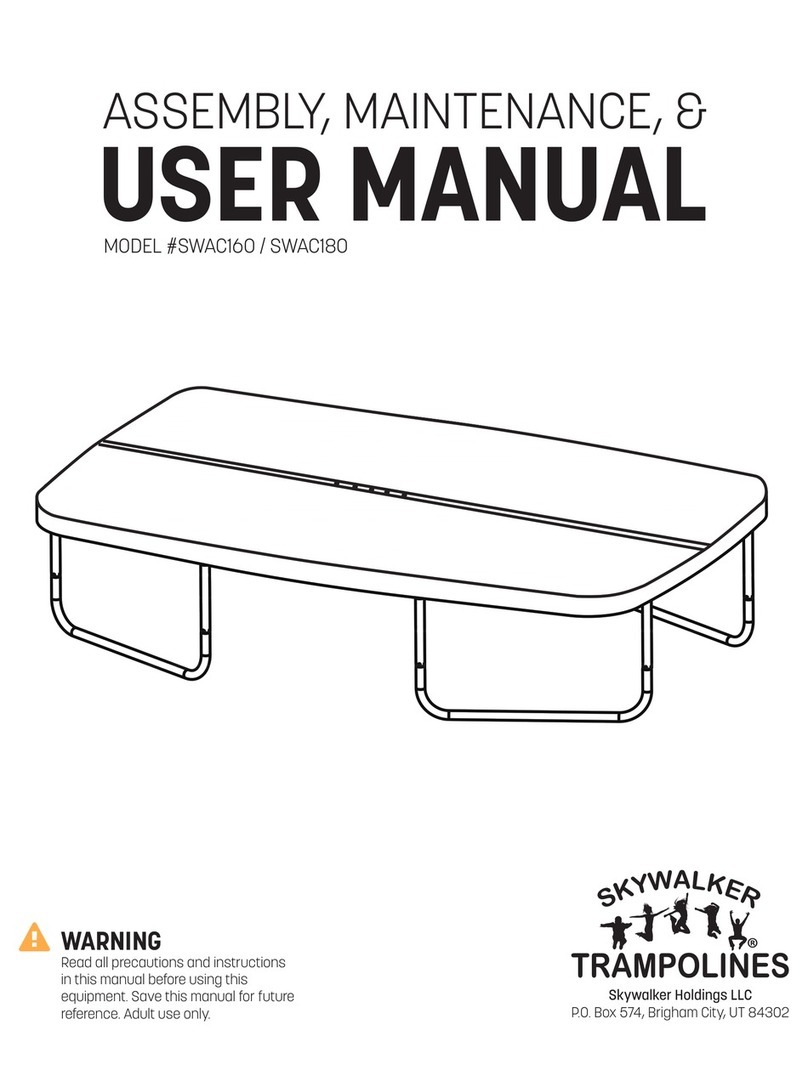
Skywalker
Skywalker SWAC160 User manual
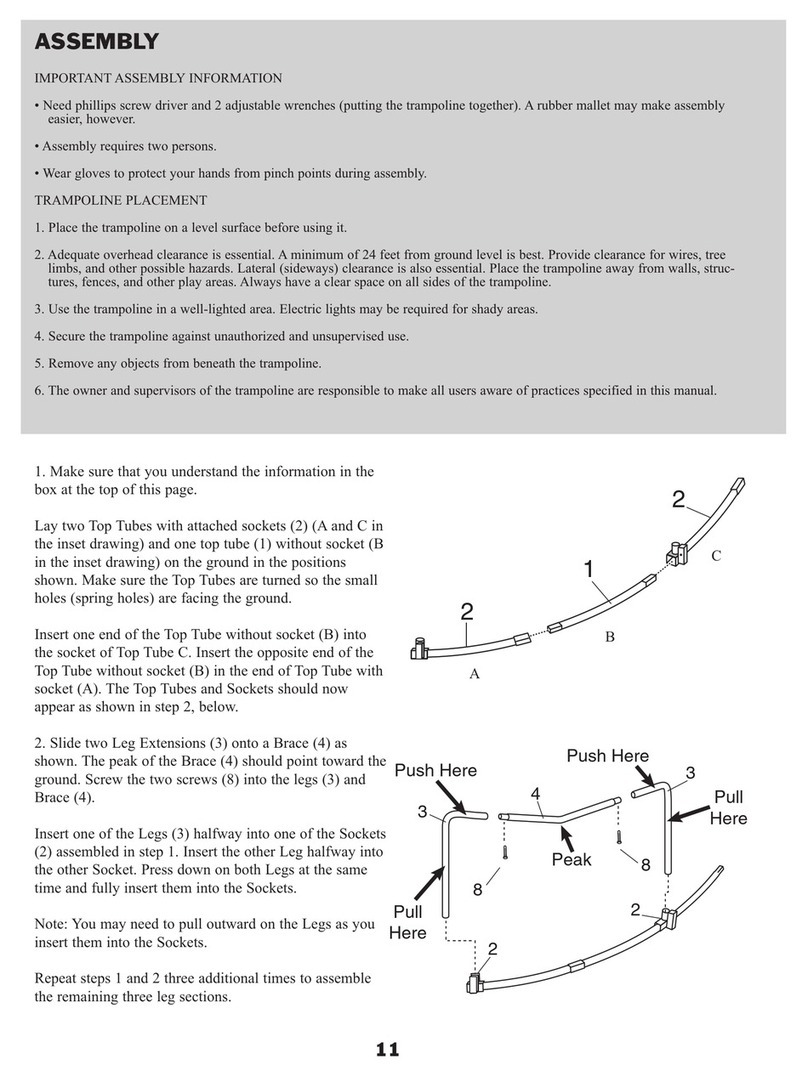
Skywalker
Skywalker Elite Series User manual


